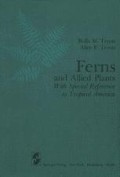Abstract
Stem erect to decumbent, massive, usually dichotomously branched, or with a single arborescent trunk, medullated protostelic, becoming dictyostelic, indurated, lacking indument; leaves usually ca. 1–2 m long, pinnate, bearing trichomes, at least when young, circinate in the bud, petiole with an expanded, stipular base; sporangia separate or in loose clusters, borne on wholly fertile parts of the lamina or on the abaxial surface of relatively unmodified segments, with a short, many-rowed stalk, and a poorly differentiated annulus; homosporous, spores with chlorophyll (green). Gametophyte epigeal, with chlorophyll, obcordate to elongate, with a thickened center and thin margins, the archegonia borne on the lower surface in rows along both sides of the thickened portion, the several- to many-celled antheridia mostly on the lower surface of the margins, less often at their edge.
Osmundaceae Bercht. & J. S. Presl, Přirozen. Rostl. 1: 272. 1820. Type: Osmunda L.
Access this chapter
Tax calculation will be finalised at checkout
Purchases are for personal use only
Preview
Unable to display preview. Download preview PDF.
Literature
Hewitson, W. 1962. Comparative morphology of the Osmundaceae. Ann. Mo. Bot. Gard. 49: 57–93.
Lugardon, B. 1971. Contribution à la connaissance de la morphogénese et la structure des parois sporales chez les Filicinées isosporées. 257 pp. Thèse, Univ. Paul Sabatier, Toulouse.
Lugardon, B. 1972. La structure fine de l’exospore et de la périspore des filicinées isosporées. 1. Généralitiés. Eusporangiées et Osmundales. Pollen et Spores 16: 227–261.
Miller, C. N., Jr. 1971. Evolution of the fern family Osmundaceae based on anatomical studies. Contrib. Mus. Paleont. Univ. Mich. 23: 105–169.
Literature
Bobrov, A. E. 1967. The family Osmundaceae (R. Br.) Kaulf, its taxonomy and geography. Bot. Žurn. (Acad. Nauk SSSR) 52: 1600–1610.
Briggs, W. R., and T. A. Steeves. 1958. Morphogenetic studies on Osmunda cinnamomea L.—The expansion and maturation of vegetative fronds. Phytomorph. 8: 234–248.
Briggs, W. R., and T. A. Steeves. 1959. Morphogenetic studies on Osmunda cinnamomea L.—The mechanism of crozier uncoiling. Phytomorph. 9: 134–147.
Caponetti, J. D., and T. A. Steeves. 1970. Morphogenetic studies on excised leaves of Osmunda cinnamomea: histological studies of leaf development in sterile nutrient culture. Canad. Jour. Bot. 48: 1005–1016.
Haight, T. H., and C. C. Kuehnert. 1969. Developmental potentialities of leaf primordia of Osmunda cinnamomea. V. Toward greater understanding of the final morphogenetic expression of isolated set I cinnamon fern leaf primordia. Canad. Jour. Bot. 47: 481–488.
Klekowski, E. J., Jr. 1973. Genetic load in Osmunda regalis populations Amer. Jour. Bot. 60: 146–154.
Klekowski, E. J., Jr., and B. B. Berger. 1976. Chromosome mutations in a fern population growing in a polluted environment: A bioassay for mutagens in aquatic environments. Amer. Jour. Bot. 63: 239–246.
Lugardon, B. 1971. Reference under the family.
Manton, I. 1950. Problems of Cytology and Evolution in the Pteridophyta. Cambridge Univ. 316 pp. Cambridge, England.
Miller, C. N., Jr. 1967. Evolution of the fern genus Osmunda. Contrib. Mus. Paleont. Univ. Mich. 21: 139–203.
Petersen, R. L., and D. E. Fairbrothers. 1971. North American Osmunda species: A serologic and disc electrophoretic analysis of spore proteins. Amer. Midl. Nat. 85: 437–457.
Southworth, D. 1974. Solubility of pollen exines. Amer. Jour. Bot. 61: 36–44.
Steeves, T. A. 1963. Morphogenetic studies of fern leaves. Jour. Linn. Soc. (Bot.) 58: 401–415.
Stein, D. B., W. F. Thompson, and H. S. Belford. 1979. Studies on DNA sequences in the Osmundaceae. Jour. Molec. Evol. 13: 215–232.
Tatuno, S., and H. Yoshida. 1966. Karyologische utersuchungen über Osmundaceae. I. Chromosomes der gattung Osmunda aus Japan. Bot. Mag. (Tokyo) 79: 244–252.
Tatuno, S., and H. Yoshida. 1967. Karyological studies of Osmundaceae. II. Chromosome of the Genus Osmundastrum and Plenasium in Japan. Bot. Mag. (Tokyo) 80: 130–138.
Tryon, R. 1940. An Osmunda hybrid. Amer. Fern Jour. 30: 65–68.
Wagner, W. H., Jr., F. S. Wagner, C. N. Miller, Jr., and D. H. Wagner, 1978. New observations on the royal fern hybrid Osmunda × Ruggii Tryon. Rhodora 80: 92–106.
Author information
Authors and Affiliations
Rights and permissions
Copyright information
© 1982 Springer-Verlag New York Inc.
About this chapter
Cite this chapter
Tryon, R.M., Tryon, A.F. (1982). Osmundaceae. In: Ferns and Allied Plants. Springer, New York, NY. https://doi.org/10.1007/978-1-4613-8162-4_4
Download citation
DOI: https://doi.org/10.1007/978-1-4613-8162-4_4
Publisher Name: Springer, New York, NY
Print ISBN: 978-1-4613-8164-8
Online ISBN: 978-1-4613-8162-4
eBook Packages: Springer Book Archive

